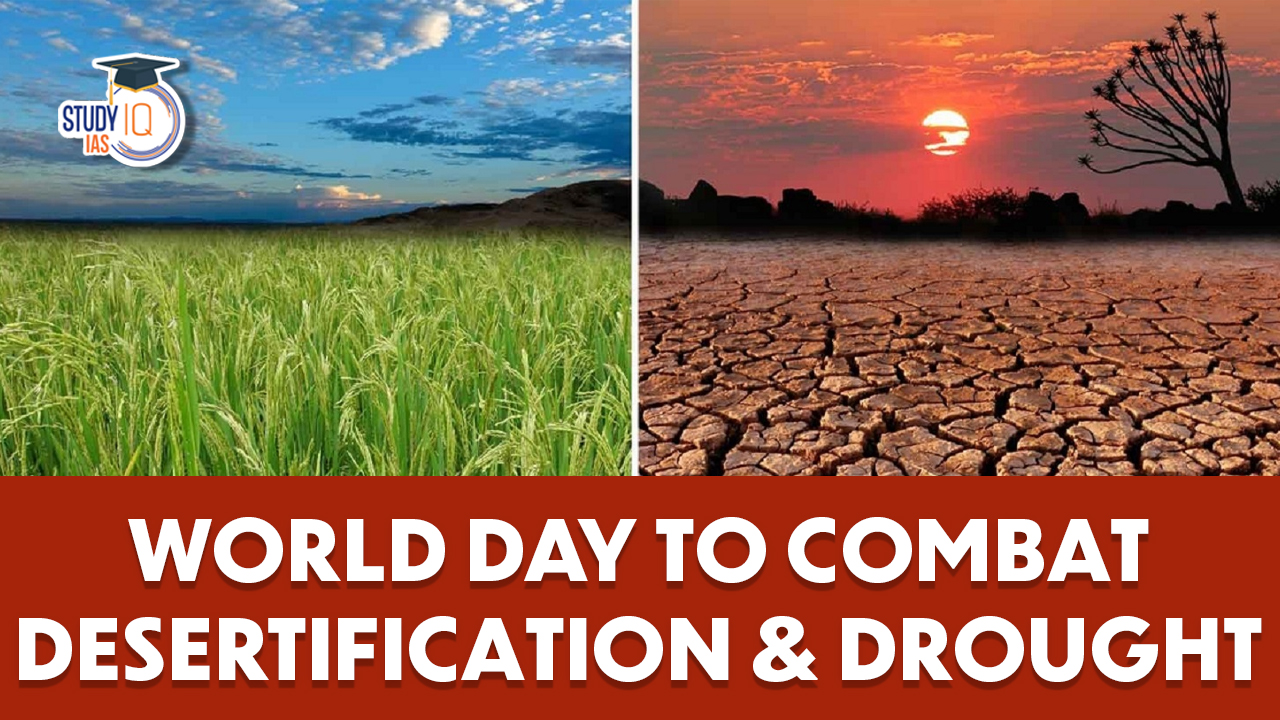Table of Contents
Every year on June 17, the world observes the World Day to Combat Desertification and Drought, a United Nations-designated day to raise awareness about the increasing threats of land degradation and drought across the globe. As the world continues to grapple with climate change, the 2025 edition of this day brings global attention to sustainable land management and the urgent need for policy action.
World Day to Combat Desertification and Drought
World Day to Combat Desertification and Drought, observed every year on June 17, aims to raise global awareness about the challenges of desertification, land degradation, and drought. Initiated by the United Nations Convention to Combat Desertification (UNCCD), this day emphasizes the urgent need for sustainable land management and climate resilience. The 2025 theme, “United for Land: Our Legacy, Our Future,” highlights collective action to protect fertile lands for future generations. With over 40% of global land degraded, this day calls on individuals, communities, and governments to restore ecosystems, conserve water, and ensure food and water security worldwide.
World Day to Combat Desertification and Drought 2025: Theme
Theme for 2025: “United for Land: Our Legacy, Our Future”
(Note: Official theme to be updated when announced by the UNCCD)
This theme emphasizes collective responsibility and intergenerational equity. It highlights how protecting land today ensures food security, climate resilience, and biodiversity for future generations.
World Day to Combat Desertification and Drought History
Since 1995, the 17th of June has been designated as the International Day to Combat Desertification and Drought. In order to raise public awareness of the problem and promote the implementation of the United Nations Convention to Combat Desertification (UNCCD), particularly in regions affected by extreme drought or desertification, the United Nations General Assembly declared June 17th as the “World Day to Combat Desertification” in the year 1994.
World Day to Combat Desertification and Drought Objective
With these Desertification and Drought Day objectives, the United Nations Convention to Combat Desertification (UNCCD) will reaffirm its commitment to gender equality.
- Highlight women’s contributions to sustainable land management and the broader SDGs;
- Raise awareness of the disproportionate impact of desertification, land degradation, and drought on women and girls and the barriers they face in decision-making on land issues;
- Raise global support for advancing land rights for women and girls around the world.
Desertification and Drought Day will be observed globally this year at the UN headquarters in New York, with activities occurring everywhere.
World Day to Combat Desertification and Drought & India’s Performance
World Day to Combat Desertification and Drought, observed on June 17, highlights the global fight against land degradation and water scarcity. In 2025, the theme “Restore the Land. Unlock the Opportunities” focuses on sustainable land restoration. India, with nearly 30% of its land degraded and 36.8% drought-prone, has pledged to restore 26 million hectares by 2030. Through initiatives like afforestation, soil health cards, and watershed development, India is actively combating desertification. Projects in Rajasthan, Haryana, and Himachal Pradesh showcase community-led success. This day urges collective global and local efforts to ensure food security, climate resilience, and a sustainable future.
World Day to Combat Desertification and Drought Significance
This day is significant because it aims to recapture lost territory. Additionally, three-quarters of the world’s ice-free land has thawed due to the constant demand for food, raw materials, roads, and houses. There should be an urgent need to recover from the epidemic and safeguard people’s and the planet’s long-term existence in order to repair these damages.
The United Nations estimates that at least 3.2 billion people are negatively impacted by land degradation. On the other hand, restoring damaged land improves food security, increases employment, income, and economic resilience. Land development affects climate change directly, resulting in less global warming, which has become one of the major sources of concern in recent years.
World Day to Combat Desertification and Drought 2025 Key messages
Desertification, land degradation and drought disproportionately impact women and girls, as they often do not have access to and control of land resources. They are most affected by reduced agricultural yields and increased water scarcity. In the vast majority of countries, women have unequal and limited access and control to land. In many regions, they remain subject to discriminatory laws and practices that impede their right to inherit, as well as their access to services and resources.
When women are empowered, entire families and communities benefit. In addition to being on the frontlines of land degradation and climate change impacts, women can also be at the forefront of global efforts to restore land to health and boost drought resilience. Gender-responsive land restoration is a pathway to reduce poverty, hunger, and malnutrition. Investing in women’s equal access to land and associated assets is a direct investment in their future and the future of humanity. Securing women’s land rights can help advance global gender equality and land restoration goals and contribute to the achievement of broader Sustainable Development Goals.
World Day to Combat Desertification and Drought UPSC
Despite having a significant stake in the health of the land, women frequently lack authority over it. Women confront tremendous obstacles in obtaining land rights anywhere in the world, which limits their capacity to flourish and succeed. Women are frequently the ones who suffer the most when the environment degrades and water becomes scarce. Equal access for women to land and related resources is an investment in both their future and the future of humanity.


 UPSC CMS Admit Card 2025 Out: Download L...
UPSC CMS Admit Card 2025 Out: Download L...
 UPSC Study Material for Prelims & Ma...
UPSC Study Material for Prelims & Ma...
 NATO Countries List 2025, Members, Funct...
NATO Countries List 2025, Members, Funct...





















